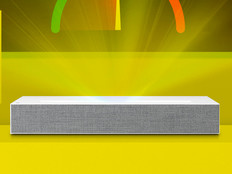Review: Epson PowerLite 435W
Epson's PowerLite 435W is very close to being the perfect projector for any classroom or meeting room, allowing teachers and other school users to present both audio and video content over the local area network via an array of connections, including computer/VGA, HDMI, S-Video and USB. With 3,000 lumens of white and color light output, native 1280x800 resolution, and a 16:10 aspect ratio, the PowerLite 435W projects bright, clear images of up to 80 inches in any lighting situation — and it does it from a distance just under 3 feet away.
End-User Advantages
Even technology novices can connect and operate this short-throw projector in a matter of minutes, thanks to its intuitive design. Within five seconds of pushing the power button, I was projecting images. Although some network projectors struggle with YouTube videos streaming from a notebook computer — a must-have activity for many 21st century classrooms — the 435W performed this task beautifully.
The software utility that comes with the 435W allows users to connect easily to any Epson projector on the school network, which is especially helpful for teachers who change classrooms — and for administrators who bounce between meetings — throughout the day. As long as the notebook and the projector are on the same network, the software will display all of the projectors that it can see and allow users to connect and display their screens.
The 435W also includes built-in teaching aids, such as grids and frequently used images. Users lacking a notebook computer can plug in a USB flash drive to access and display desired content. Virtual and physical remote controls offer another easy way to navigate through files.
Users can connect up to 16 computers to one projector via the network using Epson's EasyMP Multi PC Projection software and then select up to four of them and project their screens. I tested this feature using three computers and found that it worked very well.
Why It Works for IT
The PowerLite 435W offers both LAN and wireless connectivity options so users can join their school's existing wireless network. The wireless settings on some other projectors, on the other hand, only allow IT managers to create an ad hoc wireless network, which is not ideal.
The IT department will appreciate the 435W's many notification features, including Simple Network Management Protocol software and e-mail alerts that can be set up to inform technical support staff when a filter needs to be cleaned or something is malfunctioning. Automatic timer settings allow IT staff to turn the projector on or off at certain times of the day. There's also a broadcasting system that allows an administrator to quickly and easily transmit messages to all Epson projectors on the school network.
Disadvantages
When I had the projector's wireless function turned on and my notebook computer was sitting right next to it, the projector bumped my notebook off the wireless connection. If I moved my notebook a foot away or disabled the wireless on the projector, this wasn't an issue. Running a network cable to the projector rather than using wireless to connect it to a notebook is an easy work-around, of course.
When launching the EasyMP software the first time, users will encounter "quick-connect" and "advanced-connect" options. I had trouble finding my projector when I chose quick-connect, but advanced-connect worked every time. Thankfully, it is possible to set advanced-connect as the default option.







